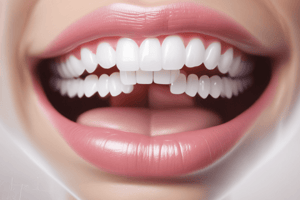Podcast
Questions and Answers
What is the active ingredient most commonly used in tooth whitening products?
What is the active ingredient most commonly used in tooth whitening products?
- Chlorine dioxide
- Carbamide peroxide
- Sodium fluoride
- Hydrogen peroxide (correct)
How does hydrogen peroxide act on tooth enamel during the whitening process?
How does hydrogen peroxide act on tooth enamel during the whitening process?
- It forms stable complex with inorganic salts
- It forms smaller, heavily pigmented components
- It attaches to organic pigment molecules directly
- It breaks down to produce unstable free radicals (correct)
What determines the tooth whitening endpoint during a bleaching treatment?
What determines the tooth whitening endpoint during a bleaching treatment?
- Time exposure and the type of toothbrush used
- Time exposure and the concentration of the bleaching compound (correct)
- Concentration of the bleaching compound and the toothbrush bristle hardness
- The type of food consumed after the treatment
What is the term used for the process of lightening the color of human teeth?
What is the term used for the process of lightening the color of human teeth?
What should dental professionals correctly diagnose to ensure successful tooth whitening treatment?
What should dental professionals correctly diagnose to ensure successful tooth whitening treatment?
What is the active ingredient most commonly used in tooth whitening products?
What is the active ingredient most commonly used in tooth whitening products?
How does hydrogen peroxide act on tooth enamel during the whitening process?
How does hydrogen peroxide act on tooth enamel during the whitening process?
What covers the small shallow ulcers in herpangina?
What covers the small shallow ulcers in herpangina?
Where do the small vesicles of herpangina form?
Where do the small vesicles of herpangina form?
What are the first oral symptoms of herpangina?
What are the first oral symptoms of herpangina?
Flashcards are hidden until you start studying
Study Notes
Tooth Whitening
- The active ingredient most commonly used in tooth whitening products is hydrogen peroxide.
- Hydrogen peroxide acts on tooth enamel during the whitening process by breaking down into oxygen free radicals, which then penetrate the tooth enamel and dentin, oxidizing and breaking down the staining molecules, resulting in a whiter appearance.
- The tooth whitening endpoint during a bleaching treatment is determined by the individual's desired level of whiteness, and can be influenced by factors such as the initial tooth shade, the type and concentration of the bleaching agent, and the duration of the treatment.
Definition of Tooth Whitening
- The term used for the process of lightening the color of human teeth is tooth whitening or teeth bleaching.
Dental Professional Diagnosis
- Dental professionals should correctly diagnose the underlying causes of tooth discoloration, such as stains, vitality, and dental work, to ensure successful tooth whitening treatment.
Herpangina
- Herpangina is a viral infection that causes small shallow ulcers to form on the mucous membranes of the mouth, which are covered by a grayish-white membrane.
- The small vesicles of herpangina form on the oral mucosa, typically on the tonsillar pillars, soft palate, and uvula.
- The first oral symptoms of herpangina are usually painful sores or ulcers on the mouth, accompanied by fever, sore throat, and difficulty swallowing.
Studying That Suits You
Use AI to generate personalized quizzes and flashcards to suit your learning preferences.




